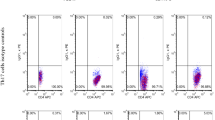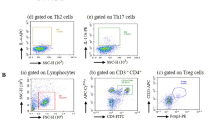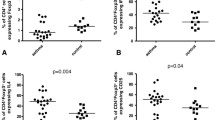Abstract
Purpose
Non-asthmatic eosinophilic bronchitis (NAEB) is a common cause of chronic cough. It is characterized by sputum eosinophilia like asthma but lacks airway hyperresponsiveness. Regulatory T cells (Tregs) are recognized as immune suppressors and are involved in the pathogenesis of asthma. However, the relationship between Tregs and NAEB remains unknown. This study aimed to preliminarily explore the role of Tregs in NAEB by comparing circulating Tregs levels to asthma and healthy controls.
Methods
Fractional exhaled nitric oxide (FeNO), spirometry with bronchial provocation test, sputum induction and blood routine test were performed in all subjects. Peripheral blood mononuclear cells were used to detect the Tregs (CD4+CD25+CD127−/low) by flow cytometry. Relationship between the levels of circulating Tregs and clinical indexes was also observed.
Results
A total of 15 patients with NAEB, 20 patients with asthma and 11 healthy controls were included. The absolute numbers of circulating Tregs in the NAEB group (49.8 ± 18.9 × 103 cells/ml) and asthma group (53.3 ± 18.7 × 103 cells/ml) were higher than that in healthy control group (32.7 ± 11.6 × 103 cells/ml) (both P < 0.01). In total, the level of circulating Tregs showed positive correlation with FeNO (r = 0.30, P < 0.05).
Conclusion
Tregs may play a key role not only in asthmatic patients, but also in patients with NAEB, as reflected by the elevated Tregs in peripheral blood.



Similar content being viewed by others

References
Gibson PG, Dolovich J, Denburg J, Ramsdale EH, Hargreave FE (1989) Chronic cough: eosinophilic bronchitis without asthma. Lancet 1:1346–1348
Lai K, Chen R, Peng W, Zhan W (2017) Non-asthmatic eosinophilic bronchitis and its relationship with asthma. Pulm Pharmacol Ther 47:66–71
Liang B, Workman C, Lee J, Chew C, Dale BM, Colonna L, Flores M, Li N, Schweighoffer E, Greenberg S, Tybulewicz V, Vignali D, Clynes R (2008) Regulatory T cells inhibit dendritic cells by lymphocyte activation gene-3 engagement of MHC class II. J Immunol 180:5916–5926
Gondek DC, Lu LF, Quezada SA, Sakaguchi S, Noelle RJ (2005) Cutting edge: contact-mediated suppression by CD4+CD25+ regulatory cells involves a granzyme B-dependent, perforin-independent mechanism. J Immunol 174:1783–1786
Stanilov NS, Miteva L, Cirovski G, Stanilova SA (2016) Increased transforming growth factor beta and interleukin 10 transcripts in peripheral blood mononuclear cells of colorectal cancer patients. Contemp Oncol (Pozn) 20:458–462
Komatsu N, Mariotti-Ferrandiz ME, Wang Y, Malissen B, Waldmann H, Hori S (2009) Heterogeneity of natural Foxp3+ T cells: a committed regulatory T-cell lineage and an uncommitted minor population retaining plasticity. Proc Natl Acad Sci USA 106:1903–1908
Belkaid Y (2007) Regulatory T cells and infection: a dangerous necessity. Nat Rev Immunol 7:875–888
Lewkowich IP, Herman NS, Schleifer KW, Dance MP, Chen BL, Dienger KM, Sproles AA, Shah JS, Kohl J, Belkaid Y, Wills-Karp M (2005) CD4+CD25+ T cells protect against experimentally induced asthma and alter pulmonary dendritic cell phenotype and function. J Exp Med 202:1549–1561
Joetham A, Schedel M, O'Connor BP, Kim S, Takeda K, Abbott J, Gelfand EW (2017) Inducible and naturally occurring regulatory T cells enhance lung allergic responses through divergent transcriptional pathways. J Allergy Clin Immunol 139:1331–1342
Afshar R, Strassner JP, Seung E, Causton B, Cho JL, Harris RS, Hamilos DL, Medoff BD, Luster AD (2013) Compartmentalized chemokine-dependent regulatory T-cell inhibition of allergic pulmonary inflammation. J Allergy Clin Immunol 131:1644–1652
Cohen RI, Ye X, Ramdeo R, Liu SF (2019) The number and function of T regulatory cells in obese atopic female asthmatics. J Asthma 56:303–310
Brightling CE (2006) Chronic cough due to nonasthmaticeosinophilic bronchitis: ACCP evidence-based clinical practiceguidelines. Chest 129:116S–121S
Lai K, Shen H, Zhou X, Qiu Z, Cai S, Huang K, Wang Q, Wang C, Lin J, Hao C, Kong L, Zhang S, Chen Y, Luo W, Jiang M, Xie J, Zhong N (2018) Clinical Practice Guidelines for Diagnosis and Management of Cough-Chinese Thoracic Society (CTS) Asthma Consortium. J Thorac Dis 10:6314–6351
Global Initiative for Asthma (2017) Global strategy for asthma management and prevention 2017. https://ginasthma.org/gina-reports/. Accessed 1 Oct 2017
American Thoracic Society, European Respiratory Society (2005) ATS/ERS recommendations for standardized procedures for theonline and ofine measurement of exhaled lower respiratory nitricoxide and nasal nitric oxide, 2005. Am J Respir Crit Care Med 171:912–930
Miller MR, Hankinson J, Brusasco V, Burgos F, Casaburi R, Coates A, Crapo R, Enright P, van der Grinten CP, Gustafsson P, Jensen R, Johnson DC, MacIntyre N, McKay R, Navajas D, Pedersen OF, Pellegrino R, Viegi G, Wanger J (2005) Standardisation of spirometry. Eur Respir J 26:319–338
Brightling CE, Symon FA, Birring SS, Bradding P, Wardlaw AJ, Pavord ID (2003) Comparison of airway immunopathology of eosinophilic bronchitis and asthma. Thorax 58:528–532
Birring SS, Parker D, Brightling CE, Bradding P, Wardlaw AJ, Pavord ID (2004) Induced sputum inflammatory mediator concentrations in chronic cough. Am J Respir Crit Care Med 169:15–19
Brightling CE, Ward R, Woltmann G, Bradding P, Sheller JR, Dworski R, Pavord ID (2000) Induced sputum inflammatory mediator concentrations in eosinophilic bronchitis and asthma. Am J Respir Crit Care Med 162:878–882
Cai C, He MZ, Zhong SQ, Tang Y, Sun BQ, Chen QL, Zhong NS (2012) Add-on montelukast vs double-dose budesonide in nonasthmatic eosinophilic bronchitis: a pilot study. Respir Med 106:1369–1375
Lai K, Liu B, Xu D, Han L, Lin L, Xi Y, Wang F, Chen R, Luo W, Chen Q, Zhong N (2015) Will nonasthmatic eosinophilic bronchitis develop into chronic airway obstruction?: a prospective, observational study. Chest 148:887–894
Noval RM, Chatila TA (2016) Regulatory T cells in allergic diseases. J Allergy Clin Immunol 138:639–652
Walker MR, Kasprowicz DJ, Gersuk VH, Benard A, Van Landeghen M, Buckner JH, Ziegler SF (2003) Induction of FoxP3 and acquisition of T regulatory activity by stimulated human CD4+CD25- T cells. J Clin Invest 112:1437–1443
Yu N, Li X, Song W, Li D, Yu D, Zeng X, Li M, Leng X, Li X (2012) CD4(+)CD25 (+)CD127 (low/-) T cells: a more specific Treg population in human peripheral blood. Inflammation 35:1773–1780
Liu W, Putnam AL, Xu-Yu Z, Szot GL, Lee MR, Zhu S, Gottlieb PA, Kapranov P, Gingeras TR, Fazekas DSGB, Clayberger C, Soper DM, Ziegler SF, Bluestone JA (2006) CD127 expression inversely correlates with FoxP3 and suppressive function of human CD4+ T reg cells. J Exp Med 203:1701–1711
Thunberg S, Gafvelin G, Nord M, Gronneberg R, Grunewald J, Eklund A, van Hage M (2010) Allergen provocation increases TH2-cytokines and FOXP3 expression in the asthmatic lung. Allergy 65:311–318
Xin L, Gao J, Ge X, Tian C, Ma W, Tian Z, Zheng X, Hou J (2018) Increased pro-inflammatory cytokine-secreting regulatory T cells are correlated with the plasticity of T helper cell differentiation and reflect disease status in asthma. Respir Med 143:129–138
Guan Q, Yang B, Warrington RJ, Mink S, Kalicinsky C, Becker AB, Simons E, Peng Z (2019) Myeloid-derived suppressor cells: Roles and relations with Th2, Th17, and Treg cells in asthma. Allergy 74:2233–2237
Hartl D, Koller B, Mehlhorn AT, Reinhardt D, Nicolai T, Schendel DJ, Griese M, Krauss-Etschmann S (2007) Quantitative and functional impairment of pulmonary CD4+CD25hi regulatory T cells in pediatric asthma. J Allergy Clin Immunol 119:1258–1266
Baatjes AJ, Smith SG, Watson R, Howie K, Murphy D, Larche M, Denburg JA, Inman MD, O'Byrne PM (2015) T regulatory cell phenotypes in peripheral blood and bronchoalveolar lavage from non-asthmatic and asthmatic subjects. Clin Exp Allergy 45:1654–1662
Yi F, Chen R, Luo W, Xu D, Han L, Liu B, Jiang S, Chen Q, Lai K (2016) Validity of fractional exhaled nitric oxide in diagnosis of corticosteroid-responsive cough. Chest 149:1042–1051
Kharitonov SA, Barnes PJ (2001) Exhaled markers of pulmonary disease. Am J Respir Crit Care Med 163:1693–1722
Nagasaki T, Matsumoto H, Izuhara K, KiHAC Respiratory Medicine Group (2017) Utility of serum periostin in combination with exhaled nitric oxide in the management of asthma. Allergol Int 66:404–410
Acknowledgements
We thank cough lab in the First Affiliated Hospital of Guangzhou Medical University for FeNO and induced sputum test. Also, we appreciate the department of pulmonary function test in the First Affiliated Hospital of Guangzhou Medical University for spirometry and bronchial provocation test.
Funding
This research was supported by grants from the National Natural Science Foundation of China (81870079), State Key Laboratory of Respiratory Disease (SKLRD-QN-201702), Undergraduate Innovation and Entrepreneurship Training Program of Guangdong Province (201810570074), and Science and Technology Innovation Program for Undergraduate of Guangdong Province (pdjh2019b0404).
Author information
Authors and Affiliations
Contributions
Conception and design: RC. Provision of study patients and data collection: JH, JL, YX, BL, YW, WL and CZ. Data analysis and interpretation: RC, CZ, JL, WL and KL. Manuscript writing: JH and JL wrote the manuscript. All authors made a revision and approve the final manuscript.
Corresponding author
Ethics declarations
Conflicts of interest
All authors have declared no conflicts of interest.
Ethical Approval
The study was approved by the Ethics Committee of the First Affiliated Hospital of Guangzhou Medical University (No: IRB2016-52).
Additional information
Publisher's Note
Springer Nature remains neutral with regard to jurisdictional claims in published maps and institutional affiliations.
Electronic supplementary material
Below is the link to the electronic supplementary material.
Rights and permissions
About this article
Cite this article
Huang, J., Liu, J., Xian, Y. et al. Elevated Circulating CD4+CD25+CD127−/low Regulatory T Cells in Patients with Non-asthmatic Eosinophilic Bronchitis. Lung 198, 491–497 (2020). https://doi.org/10.1007/s00408-020-00358-x
Received:
Accepted:
Published:
Issue Date:
DOI: https://doi.org/10.1007/s00408-020-00358-x



